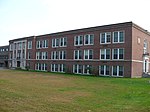Sulphite Railroad Bridge

The Sulphite Railroad Bridge, also known locally as the Upside-Down Covered Bridge is a historic railroad bridge in Franklin, New Hampshire. The bridge was built circa 1896-7 to carry the tracks of the Boston and Maine Railroad across the Winnipesaukee River between Franklin and Tilton. The bridge is believed to be the only surviving "upside down" covered railroad bridge in the United States, in which the rail bed is laid on top of the bridge roof, whose purpose is to shelter the trusses below. The bridge was listed on the National Register of Historic Places in 1975. The bridge, unused since 1973, is not in good condition, having been subjected to graffiti, vandalism, and arson, as well as the elements.
Excerpt from the Wikipedia article Sulphite Railroad Bridge (License: CC BY-SA 3.0, Authors, Images).Sulphite Railroad Bridge
Winnipesaukee Trail, Franklin
Geographical coordinates (GPS) Address Nearby Places Show on map
Geographical coordinates (GPS)
| Latitude | Longitude |
|---|---|
| N 43.445 ° | E -71.635277777778 ° |
Address
Winnipesaukee Trail
Winnipesaukee Trail
03235 Franklin
New Hampshire, United States
Open on Google Maps









